← Planet Precession | Exoplanets →
Milankovitch Cycles
Earth’s orbit changes cyclically over many thousands to hundreds of thousand years. The Milankovitch cycles are the changes in Earth’s orbit that alter the distribution and intensity of sunlight reaching Earth. Certain conditions of obliquity, eccentricity, and precession push the high latitudes into long-term cooling or warming events. When a polar region is cold enough for snow and ice to last throughout the year, it can trigger an Ice Age, a period where ice sheets grow large in the Northern Hemisphere, through a set of processes known as the Arctic amplification (see diagram on the right). But this set of interconnected processes also works in reverse: the loss of ice and snow cover may amplify a polar warming event, called an Interglacial Period, and ice sheets decrease significantly in size.
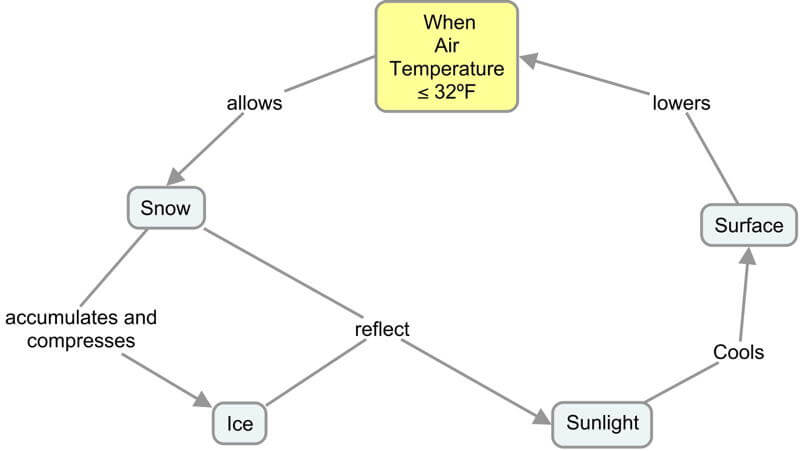
A concept map of the Arctic Amplification process, a positive feedback mechanism in which reflective snow and ice create conditions that expand the regions that support snow and ice formation.
What Conditions Create An Ice Age?
Reflective snow and ice lasting throughout the year is the critical ingredient of an Ice Age. The reflective surface keeps the area cool during the spring and summer months of extended daylight in the polar regions.
Winters will always be frigid in the polar regions due to the prolonged darkness allowing for considerable radiational cooling. Snow and ice will last during these months. That means they need to survive the summer months.
Use your understanding of how obliquity affects a planet’s radiation budget to make your predictions for the following scenarios.
Will an Ice Age form when Earth's obliquity is 90º?
The polar regions will be frigidly cold during the dark winter months. During the summer the Sun will be nearly overhead continuously for roughly a month, which would make the region blisteringly hot. No Ice Age could form with an obliquity of 90º.
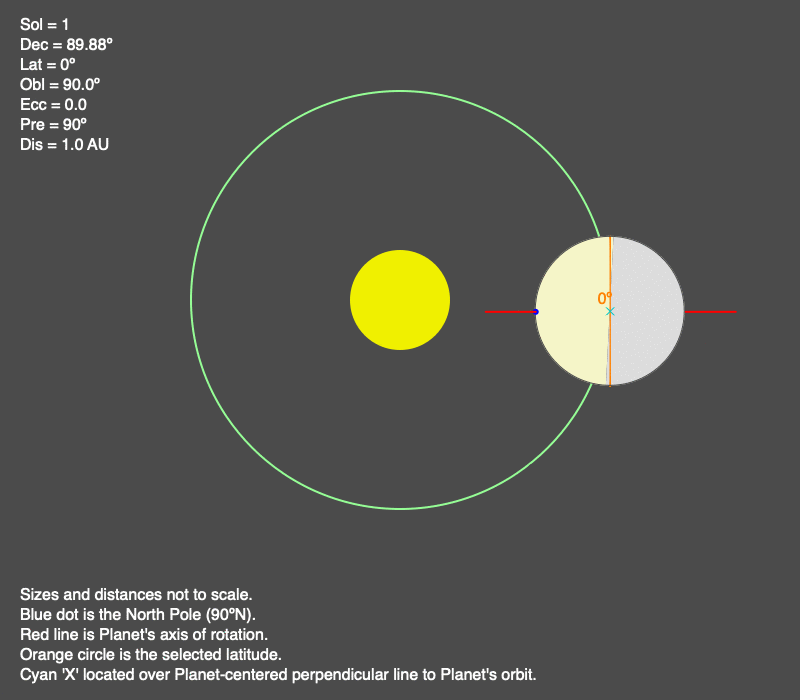
In the animation of Earth’s orbit around the Sun when the obliquity is 90º, the red line is the axis of rotation, the orange line represents the equator, the green line is the orbital path, the illuminated part of Earth is light yellow, and the shaded part is light gray.
Will an Ice Age form when Earth's obliquity is 0º?
Since the local noon sun angle will be constant throughout the year, there is only one seasonal temperature per latitude, unless eccentricity is large. The low latitudes will be consistently hot, the middle latitudes will be moderate, and the polar regions will remain frigid. If the eccentricity is large, the tropics will experience large temperature swings, the middle latitudes have moderate changes, and the polar regions will not be affected.
Because the polar regions will remain frigid year-round, glaciation will be a permanent feature at high latitudes – an eternal Ice Age!
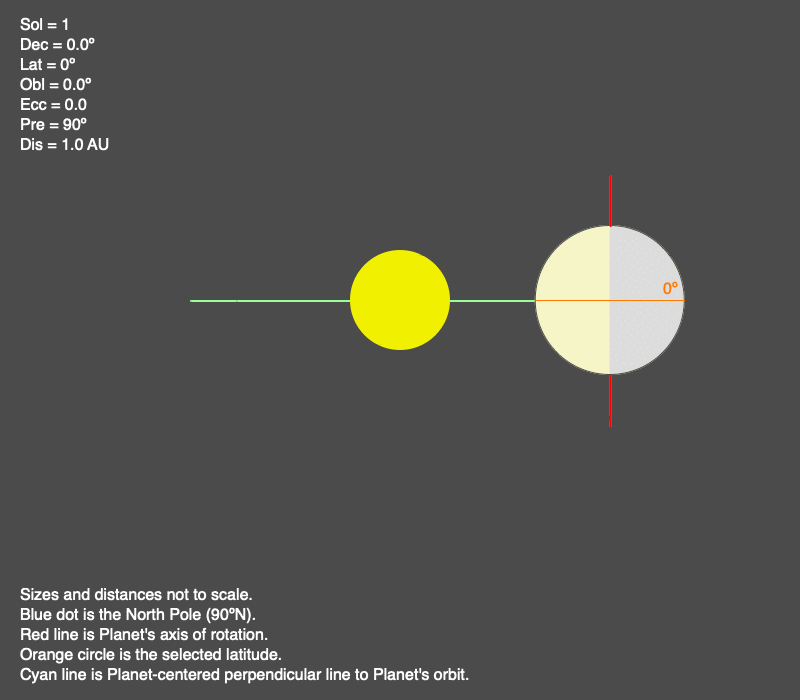
In the animation of Earth’s orbit around the Sun when the obliquity is 0º, the red line is the axis of rotation, the orange line represents the equator, the green line is the orbital path, the illuminated part of Earth is light yellow, and the shaded part is light gray.
Earth’s Orbital Cycles
The gravitational pull from the Sun and planets on Earth is constantly changing. The varying magnitudes and directions of pull cause long-term cyclical changes in Earth’s obliquity, eccentricity, and precession. A cycle’s period is the time it takes to repeat the pattern. For example, Earth will have an obliquity of 23.5º that is decreasing over time in another 41,000 years.
Earth’s Orbital Changes
| Obliquity | Eccentricity | Precession | |
| Current | 23.5º | 0.0167 | 256º¹ |
| Minimum | 22.1º | 0.000055 | 0º |
| Maximum | 24.5º | 0.0679 | 360º |
| Period [Years] | 41,000 | 100,000 | 26,000 |
¹ Precession doesn’t have a standard coordinate system. The current value is based on the direction convention of the orientation of the axis of rotation in Sun-Earth Connection and Star-Planet-Connection software.
Which Conditions Favor a Glacial Period?
Ice Ages need cool/cold summers in the polar latitudes. These are favored by the lowest obliquities and the summer solstice occurring when furthest from the Sun. More elliptical orbits create an aphelion further from the Sun. Precession comes into play so that the Northern Hemisphere’s summer solstice occurs close to the aphelion.
What about the Southern Hemisphere? Milankovitch cycles do have an effect, but there are special conditions due to the nearby ocean currents that strongly influence the climate in the southern polar region too.
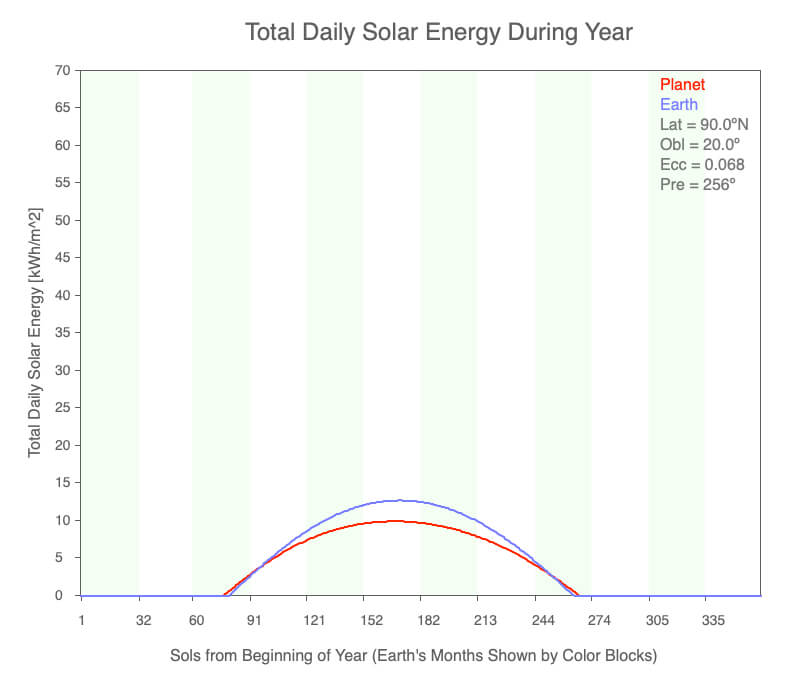
Comparison of the total daily solar energy (TDSE) during the year at the North Pole (90ºN) for present-day Earth (blue line) and when the Earth has its minimum obliquity, maximum eccentricity, and the precession aligns the summer solstice while at aphelion (red line).
Which Conditions Favor an Interglacial Period?
Interglacial periods are warm episodes in which polar ice melts/retreats. Interglacials need a warm/hot summer in the polar latitudes. These are favored by the highest obliquities and the summer solstice occurring when closest to the Sun. More elliptical orbits create a perihelion closer to the Sun. Precession comes into play so that the Northern Hemisphere’s summer solstice occurs close to the perihelion.
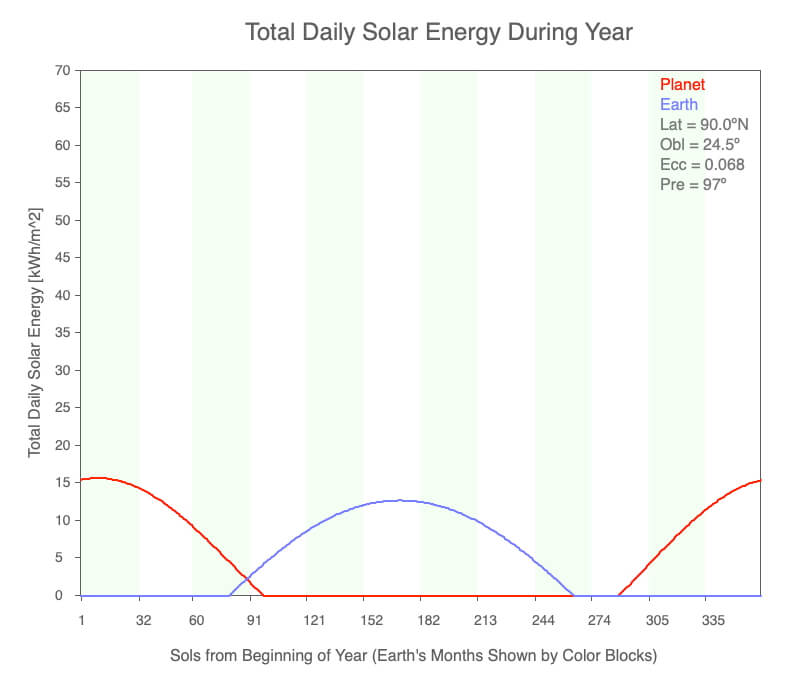
Comparison of the total daily solar energy (TDSE) during the year at the North Pole (90ºN) for present-day Earth (blue line) and when the Earth has its maximum obliquity, maximum eccentricity, and the precession aligns the summer solstice while at perihelion (red line).
Additional Resources
This article discusses how the Milankovitch Cycles help explain the patterns found in relatively recent paleoclimate data recorded in rocks, sediment, and ice. And this article goes into more detail about the effects of the Milankovitch cycles on Earth and the other planets in our solar system. Interestingly, glacial episodes occur sporadically through Earth’s history, so there are other factors involved that cause Ice Ages. This should be expected since the Milankovitch Cycles impact the Earth’s radiation budget, which is only one component of its total energy budget. For this, we need to account for all major components of heat transfer, CRACL. Many of the remaining topics in Earth Systems explore these processes, particularly advection, convection, and latent heat in the oceans and atmosphere.
Continue Exploring the Milankovitch Cycles Impact on Earth’s Radiation Budget
Use the desktop app, Star-Planet Connection, to explore how Earth’s changes in obliquity, eccentricity, and precession impact its radiation budget. Download Mac or PC versions at the Software page.
Big Ideas
- The Milankovitch cycles are the changes in Earth’s orbit that alter the distribution and intensity of sunlight reaching Earth.
- Certain conditions of obliquity, eccentricity, and precession push the high latitudes into long-term cooling or warming events.
← Planet Precession | Exoplanets →

0 Comments